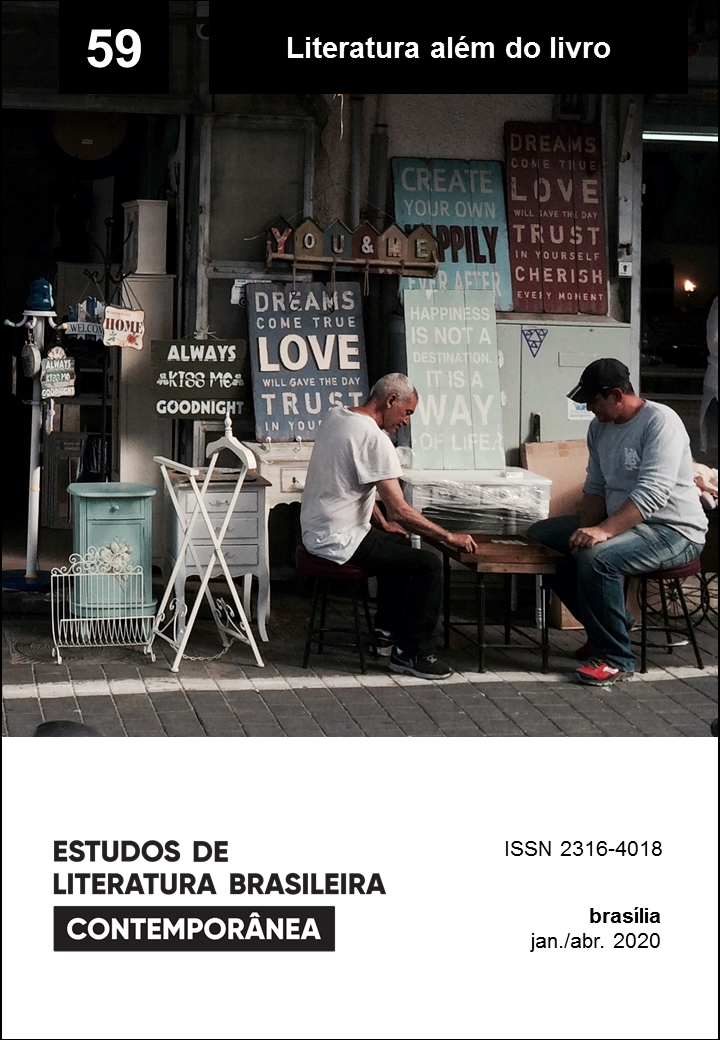La flâneuse en la literatura brasileña: espacios y temporalidades contestados
DOI:
https://doi.org/10.1590/2316-40185910Palabras clave:
flâneur, flâneuse, mobilidade, género, literaturaResumen
La cuestión del espacio, y su “producción”, según Lefebvre (1975), se ha revelado una rica área de investigación para los estúdios literários, así como las cuestiones ligadas a mobilidade en sus distintas realidades: desde las experiencias de migración y diaspora a transitos urbanos, para citar algunos ejemplos. En este contexto, la figura del flâneur, intrinsicamente ligada a las experiencias y representaciones de la modernidad urbana, ha atraido considerable interés crítico. En geral, poco estudada ainda ha sido la figura de su equivalente feminino, la flâneuse, pues, como bien observa Wolff (1985), la experiencia de la modernidade ha sido, en grande parte, narrada desde un punto de vista predominantemente masculino. A partir del cuento “Amor”, de Clarice Lispector (1960/1998), y del texto “Um corpo negro pelado” [Un cuerpo negro desnudo] de Miriam Alves (2014), este artigo estuda de que forma parecen dialogar con este paradigma de la mobilidad moderna. Discutirá de que manera podemos pensar mujeres en transito en la literatura brasileña contemporanea escrita por mujeres como tentativas de repensar la experiencia de esta mobilidad, ahora como un acto político y de busca de empoderamento feminino.
Descargas
Citas
ALVES, Miriam (2014). O corpo negro pelado. Modo de Usar & CO., 19 jan. Disponível em: https://bit.ly/362PqOC. Acesso em: 30 nov. 2017.
BAUDELAIRE, Charles (1857/1985). As flores do mal. Tradução de Ivan Junqueira.. Rio de Janeiro: Nova Fronteira. Edição bilíngue
BENJAMIN, Walter (1973). Charles Baudelaire: a lyric poet in the era of high capitalism. Londres: Verso.
BENJAMIN, Walter (1999). On some motifs in Baudelaire. In: BENJAMIN, Walter. Illuminations. Edição e introdução de Hannah Arendt. Prefácio de Leon Wieseltier. Tradução de Harry Zorn. Londres: Pimlico.
CARRERA SUÁREZ, Isabel (2015). The stranger flâneuse and the aesthetics of pedestrianism: writing the post-diasporic metropolis. Interventions, v. 17, n. 6, p. 853-865, 7 jan.
CERTEAU, Michel de (1980). L’invention du cotidien. Paris: Gallimard.
CHIARELLI, Stefania; OLIVEIRA NETO, Godofredo de (2016) (Org.). Falando com estranhos: o estrangeiro e a literatura brasileira. Rio de Janeiro: 7 Letras.
COSGROVE, Dennis (1984). Social formation and symbolic landscape. Londres: Croom Helm.
CRESSWELL, Tim (2006). On the move: mobility in the modern world. New York; Abingdon: Routledge.
FERGUSON, Priscilla Parkhurst (1994). The flâneur on and off the streets of Paris. In: TESTER, Keith (Ed.). The flâneur. Londres: Routledge. p. 22-42.
HARVEY, David (2008). The right to the city. The New Left Review, n. 53, p. 23-40, set./out.
LEFEBVRE, Henry (1968/1996). The right to the city. In: KOFMAN, Eleonore; LEBAS, Elizabeth (Ed.). Writings on cities. Cambridge, MA: Blackwell, p. 147-159.
LEFEBVRE, Henry (1974). La production de l’espace. Paris: Anthropos.
LISPECTOR, Clarice (1960/1998). Laços de família. Rio de Janeiro: Rocco.
LITERAFRO (2019). Miriam Alves. Disponível em: http://www.letras.ufmg.br/literafro/autoras/348-miriam-alves. Acesso em: 14 mar. 2019.
MORETTI, Franco (1998). An Atlas of the European Novel 1800-1900. Londres: Verso.
PEIXOTO, Marta (1994). Passionate fictions. Minneapolis; London: University of Minnesota Press.
POLLOCK, Griselda (1988). Vision and difference. Londres: Routledge.
ROBILA, Mihaela (2018). Refugees and social integration in Europe. New York: Undesa. Disponível em: https://bit.ly/2tgntpy. Acesso em: 22 fev. 2019.
ROSENTHAL, Anton (2016). The streetcar in the urban imaginary of Latin America. Journal of Urban History, v. 42, n. 1, p. 162-179, jan.
SCHULTE NORDHOLT, Annelies (2008). Georges Perec: topographies parisiennes du flâneur. Revue Électronique de Littérature Française, v. 2, n. 1, p. 66-86, 19 mar.
SHELLER, Mimi; URRY, John (Ed.) (2004). Tourism mobilities: places to play, places in play. London; New York: Routledge.
TONUS, José Leonardo (2012). O imigrante na literatura brasileira: instrumentalização de uma figura literária. In: DALCASTAGNÈ, Regina; MATA, Anderson Luís Nunes da (Org.). Fora do retrato: estudos de literatura brasileira contemporânea. Vinhedo: Horizonte. p. 93-101.
VILA-CABANES, Isabel (2018). The flaneur in nineteenth-century british literary culture: the worlds of London unknown. Newcastle: Cambridge Scholars Press.
WEJSA, Shari; LESSER, Jeffrey (2018). Migration in Brazil: the making of a multicultural society. The Online Journal of Migration Policy Institute, Washington, 29 mar. Disponível em: https://bit.ly/2uF3yRv. Acesso em: 7 mar. 2019.
WILSON, Elizabeth (1992). The invisible flâneur. New Left Review, n. 191, p. 90-110, jan./fev.
WOLFF, Janet (1985). The invisible flâneuse: women and the literature of modernity. Theory, Culture & Society, v. 2, n. 3, p. 37-46, nov.
Descargas
Publicado
Cómo citar
Número
Sección
Licencia
Los autores que publican en esta revista concuerdan con los siguientes términos:
a) Los (los) autores (s) conservan los derechos de autor y conceden a la revista el derecho de primera publicación, siendo el trabajo simultáneamente licenciado bajo la Licencia Creative Commons de Atribución-No Comercial 4.0, lo que permite compartir el trabajo con reconocimiento de la autoría del trabajo y publicación inicial en esta revista.
b) Los autores (a) tienen autorización para asumir contratos adicionales por separado, para distribución no exclusiva de la versión del trabajo publicada en esta revista (por ejemplo, publicar en repositorio institucional o como capítulo de libro), con reconocimiento de autoría y reconocimiento publicación inicial en esta revista.
c) Los autores tienen permiso y se les anima a publicar y distribuir su trabajo en línea (por ejemplo, en repositorios institucionales o en su página personal) después del proceso editorial, ya que esto puede generar cambios productivos, así como aumentar el impacto y la citación del trabajo publicado (ver el efecto del acceso libre).
d) Los (as) autores (as) de los trabajos aprobados autorizan la revista a, después de la publicación, ceder su contenido para reproducción en indexadores de contenido, bibliotecas virtuales y similares.
e) Los (as) autores (as) asumen que los textos sometidos a la publicación son de su creación original, responsabilizándose enteramente por su contenido en caso de eventual impugnación por parte de terceros.


